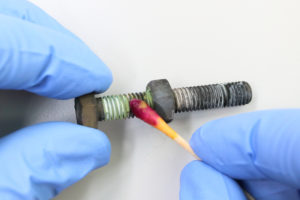Frequently asked questions
Chromium-6 on heated steel
Chromium-6 compounds can be formed after heat treatment of chromium-containing metals such as stainless steel, for example in heated machine parts of a (wind) turbine or engine. Heating can also take place during grinding or welding. The formation of chromium-6 on metals often occurs when lubricants (known as 'anti-seize paste') are used to prevent the seizing of bolts or parts. These heated lubricants often have a yellow/green colour (see photo of bolt and nut on the left). Detection of these chromium-6 contaminations on metals is important to prevent exposure to chromium-6.
Example of a stainless steel 304 (A2) bolt and nut with anti-seize paste after heat treatment. The formed yellow/green chromate is clearly visible. The test swab of the TK11™ Chromium-6 Detection Test Kit clearly turns red/purple, indicating that chromium-6 is present.
For more information: see the report about our investigations on the detection of chromium-6 in heated lubricants on stainless steel >>
The TK11 Chromium-6 Detection Test Kit has been developed and validated for use within an operational ambient temperature range of 0ºC to 50ºC. Therefore, machine components must be allowed to cool down naturally in air before testing. During testing, the metal surface itself may have a temperature of up to 70°C, but we prefer a temperature of 50°C or lower, which is also more practical for handling.
The same applies to the TK20 Chromium-6 Neutralizer, which is only effective on components that have cooled to room temperature through natural air cooling. For neutralisation, the metal surface may have a temperature of up to 50°C.
This can be done in a simple way with our TK11 Test Kit:
- Rub the moistened test swab over the surface of the stainless steel.
- If the test swab turns purple, it indicates the presence of chromium-6 on the surface.
- If the test swab remains orange, it indicates that no chromium-6 is present.
Example of a stainless steel 304 (A2) bolt and nut with anti-seize paste after heat treatment. The formed yellow/green chromate is clearly visible. The test swab of the TK11™ Chromium-6 Detection Test Kit clearly turns red/purple, indicating that chromium-6 is present.
Chromium-6 can form on heated stainless steel or other chromium-containing alloys when they come into contact with anti-seize compounds or insulation materials such as glass wool or mineral wool. A chemical reaction between elements such as calcium and sodium (present in the anti-seize compound or insulation) and the chromium in the metal can produce carcinogenic chromium-6 compounds, such as calcium chromate. These often appear as a white, yellow, or green powdery layer on the metal surface or on the insulation material. Such chromates form at elevated metal temperatures.
Our chromium-6 test kit and neutraliser solution are frequently used in the maintenance of components in gas turbines, among other machines. These turbines reach high temperatures, for example at the exhaust. The metal parts of such machines are often insulated with materials such as mineral wool, and anti-seize agents are used for the bolts, both of which can contribute to the formation of chromium-6 compounds. Besides gas turbines, chromium-6 compounds may also form on marine engines, aircraft turbines, wind turbines, and other industrial machinery.

